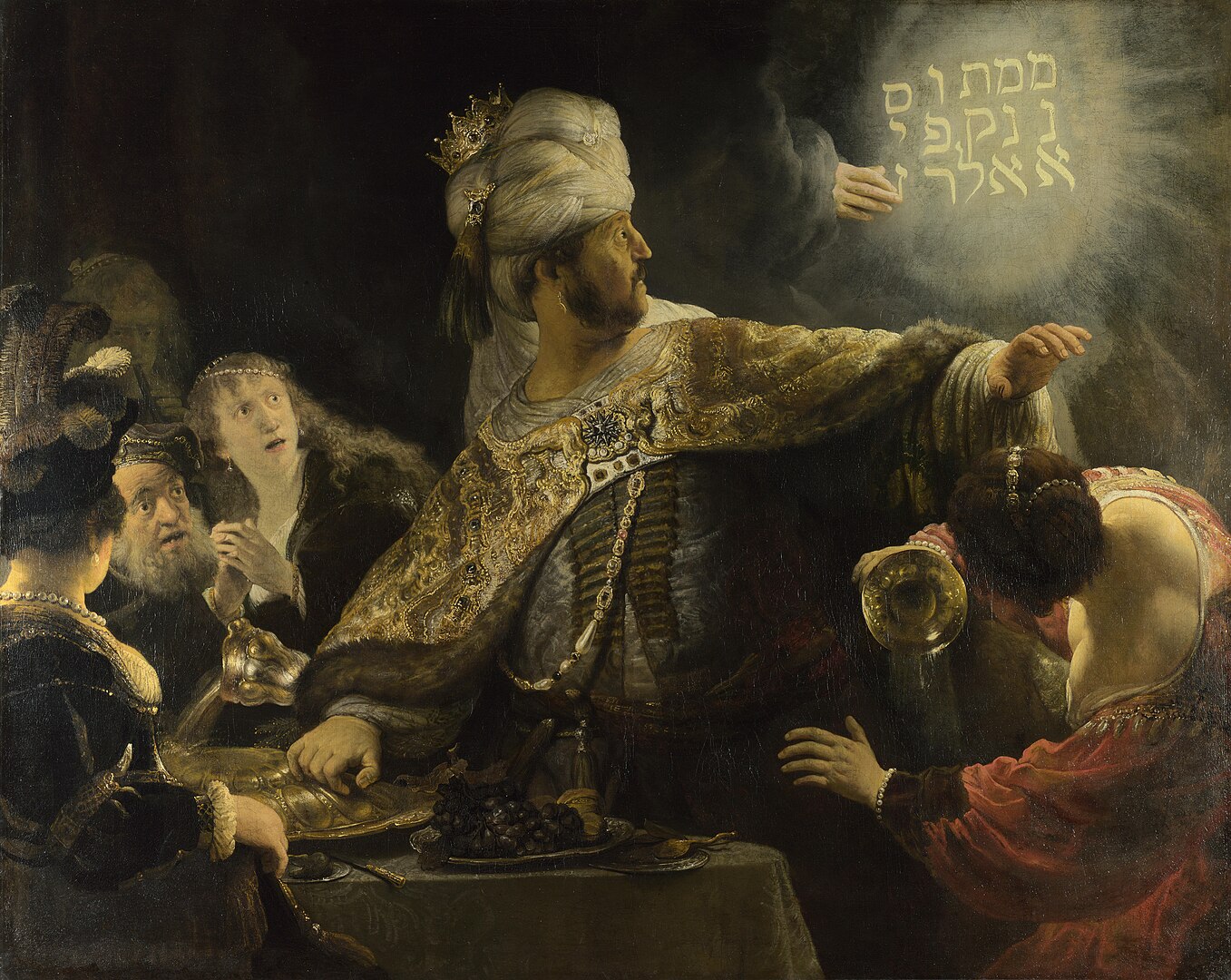
Meaning of Belshazzar’s Feast Painting by Rembrandt
In the rich tapestry of Baroque art, where shadow and light grapple in dramatic dances, few paintings evoke the sheer drama and spiritual terror of Rembrandt van Rijn’s Belshazzar’s Feast. Painted between 1635 and 1638, this masterwork immerses the viewer in a biblical moment of divine reckoning, capturing with breathless immediacy the downfall of an arrogant king. Yet, beyond its overt dramatization lies a deep well of symbolism, theological resonance, and artistic mastery.
This article embarks on a detailed journey into the world of Belshazzar’s Feast, unpacking its visual composition, narrative, symbolic layers, and Rembrandt’s personal engagement with history and scripture. Let us begin by understanding the story behind the painting.
The Biblical Narrative Behind the Painting
Belshazzar’s Feast draws from the Book of Daniel, chapter 5, in the Old Testament. The scene takes place in the ancient city of Babylon, under the rule of King Belshazzar, son or successor of Nebuchadnezzar. According to the scripture, Belshazzar hosts a lavish feast for a thousand of his nobles, during which he orders that the sacred vessels looted from the Jewish temple in Jerusalem be brought in and used for drinking wine.
In a gesture of blasphemous arrogance, the king and his guests praise the gods of gold, silver, bronze, iron, wood, and stone, desecrating the holy items. At that moment, a mysterious hand appears and writes a cryptic message on the wall: “MENE, MENE, TEKEL, UPHARSIN.” None of Belshazzar’s wise men can interpret the message. Only Daniel, a Jewish captive and prophet, is able to explain it:
MENE – God has numbered the days of your reign and brought it to an end.
TEKEL – You have been weighed on the scales and found wanting.
PERES (UPHARSIN) – Your kingdom is divided and given to the Medes and Persians.
That very night, Belshazzar is slain, and Darius the Mede takes over the kingdom.
What Is Happening in Rembrandt’s Painting?
Rembrandt’s Belshazzar’s Feast captures the precise moment the mysterious hand writes on the wall. The focal point is King Belshazzar, who recoils in stunned terror, his body twisting as he stares at the glowing Hebrew script written in radiant light.
The scene is chaotic. A luxurious banquet is suddenly disturbed by divine intervention. Wine spills from golden vessels, expressions of horror freeze on the guests’ faces, and the heavenly script casts an eerie glow on the figures. The abruptness of judgment, the collapse of pride into fear, and the spectacle of divine omnipotence all unfold in a single, breathless instant.
Rembrandt doesn’t show the aftermath, the king’s death, or the fall of Babylon. Instead, he immortalizes the suspenseful moment where judgment is revealed, but its consequences have yet to unfold. This choice enhances the painting’s emotional and psychological intensity.
Who Painted It and When?
Rembrandt van Rijn, one of the greatest painters of the Dutch Golden Age, painted Belshazzar’s Feast sometime between 1635 and 1638, while he was living in Amsterdam. Though best known for his portraits and religious scenes, Rembrandt rarely painted large-scale history paintings, and Belshazzar’s Feast is one of his boldest attempts in this genre.
This was an ambitious undertaking for Rembrandt, who was still in his twenties at the time. His goal was likely to establish himself as a grand history painter, a genre highly regarded at the time and associated with intellectual depth, narrative complexity, and dramatic scale.
Interestingly, Rembrandt never received a commission for this work, it was a speculative piece, painted in hopes of elevating his reputation.
How Did Rembrandt Create the Painting?
Rembrandt’s painting is oil on canvas, measuring approximately 167.6 cm × 209.2 cm (66 x 82 inches). It was painted using techniques characteristic of Baroque art, especially chiaroscuro, the dramatic contrast of light and dark that lends three-dimensional form and emotional weight to the figures.
In terms of composition, Rembrandt chose a theatrical arrangement: Belshazzar dominates the center, lavishly robed and adorned in finery, but his figure is collapsing sideways under the weight of terror. His startled eyes direct the viewer’s gaze to the ghostly writing. Around him, other figures echo the shock, forming a visual spiral that guides the viewer through the painting.
The palette is rich, gold, crimson, and royal blue dominate the clothing and décor, suggesting opulence, pride, and decadence. But these colors also contrast with the divine light of the writing, which cuts through the human artifice with ethereal intensity.
Symbolism and Meaning in the Painting
Rembrandt, deeply immersed in the Judeo-Christian tradition, used symbolism to heighten the meaning of the painting:
1. The Golden Vessels
The vessels are key to the blasphemy that triggers God’s wrath. These were sacred items stolen from the Jewish Temple in Jerusalem, and their misuse symbolizes not only pride but sacrilege. By prominently featuring these golden cups, Rembrandt highlights the reason for Belshazzar’s downfall.
2. The Hebrew Script
The glowing inscription on the wall is a central element of the painting. Interestingly, Rembrandt consulted actual Hebrew scholars for accuracy. He was familiar with Jewish traditions, his neighborhood in Amsterdam was home to many Sephardic Jews. The letters are written in Hebrew, in vertical columns (as was the ancient style), though scholars debate the exact arrangement. Rembrandt painted the script in glowing gold, making it look supernatural, and its vertical arrangement enhances its alien, divine quality.
3. Belshazzar’s Expression
The painting is ultimately a study in fear. The expression on the king’s face, wide eyes, open mouth, contorted body, conveys the moment when human arrogance is shattered by divine power. This terror is not merely physical but spiritual, as Belshazzar realizes he has crossed a sacred boundary.
4. Divine Judgment
The message “MENE, MENE, TEKEL, UPHARSIN” has a dual symbolism: it’s both a prophecy and a verdict. It foreshadows the end of a kingdom and acts as a moral warning. The idea that power is transient and accountable to higher laws runs through much of Rembrandt’s religious work.
5. Opulence vs. Judgment
Rembrandt visually contrasts earthly grandeur with divine judgment. The gold, fine fabrics, jewels, and ornate setting all emphasize worldly power. But all of it is meaningless in the face of God’s hand. This juxtaposition underscores the painting’s central message: pride precedes the fall.
Artistic Style: What Kind of Art Is This?
Belshazzar’s Feast is a quintessential example of Baroque art, specifically, Northern Baroque, which flourished in the Dutch Republic in the 17th century. This period emphasized drama, realism, and intense emotion, often using light and shadow to convey psychological states.
Unlike the Italian Baroque masters like Caravaggio or Rubens, Rembrandt infused his work with a particularly introspective, moral, and spiritual depth. His characters are not idealized; they are profoundly human, vulnerable, and relatable. This painting straddles the line between history painting and biblical narrative, genres that demanded intellectual engagement and a strong moral lesson.
Another hallmark of Baroque art present in the painting is tenebrism, the use of strong contrasts between light and dark to create volume and highlight important elements. The glowing script, the king’s illuminated face, and the sudden intrusion of divine light heighten the painting’s tension and meaning.
Why Did Rembrandt Choose This Subject?
There’s no definitive answer, but several theories exist:
Ambition: Rembrandt may have chosen the story to prove himself capable of executing a grand historical painting. The dramatic, divine subject matter gave him an opportunity to demonstrate technical prowess and narrative skill.
Theological Interest: Rembrandt had a deep interest in biblical stories, especially those with themes of divine justice and moral consequence. Belshazzar’s arrogance and fall might have resonated with Rembrandt’s view of the moral order of the world.
Cultural Context: In the Protestant Dutch Republic, where idolatry and excess were viewed critically, the story of a pagan king punished for blasphemy would have had a strong cultural resonance.
Reception
Curiously, Belshazzar’s Feast was not widely known or celebrated in Rembrandt’s lifetime. It was overshadowed by his portraits and etchings. It wasn’t until the 19th and 20th centuries that the painting gained recognition as one of his boldest and most powerful religious works.
The painting’s intensity, use of light, and psychological realism have inspired countless artists and scholars. Its depiction of divine judgment remains one of the most arresting in Western art.
Where Is the Painting Today?
Today, Rembrandt’s Belshazzar’s Feast resides in the National Gallery, London. It was acquired in the 20th century and has become one of the museum’s prized works. Despite being less famous than The Night Watch or The Return of the Prodigal Son, this painting continues to captivate audiences with its explosive energy and haunting moral message.
A Visual Sermon of Judgment and Hubris
Belshazzar’s Feast is not merely a depiction of a biblical story; it is a visual sermon on pride, accountability, and divine justice. In a single moment, Rembrandt captures the fall of a mighty king, the terror of divine intervention, and the eternal truth that power without humility is fleeting.
Through rich symbolism, masterful composition, and emotional intensity, Rembrandt transforms scripture into spectacle, but one grounded in moral gravity. As the divine hand writes across the canvas of Belshazzar’s palace, so too does Rembrandt write upon the hearts of his viewers a timeless warning: No throne is higher than the will of the divine.




